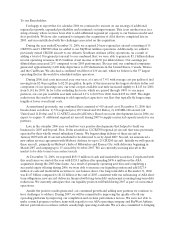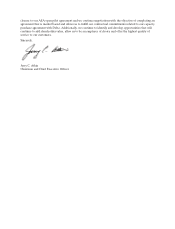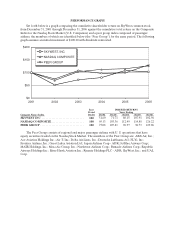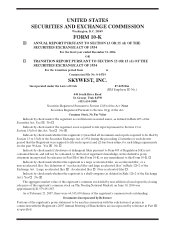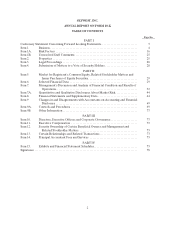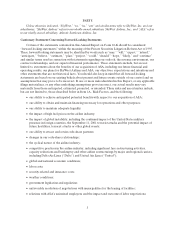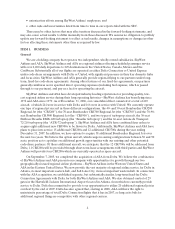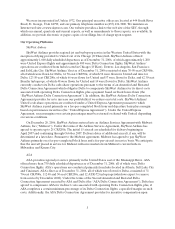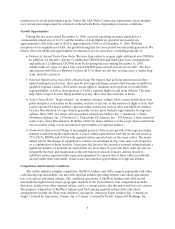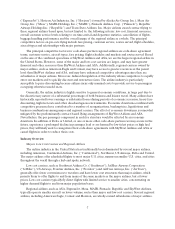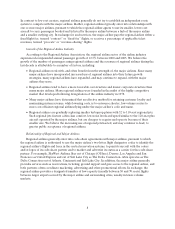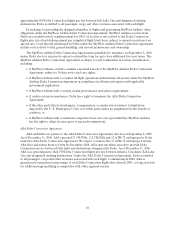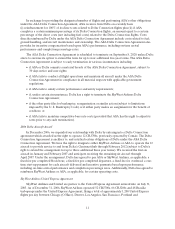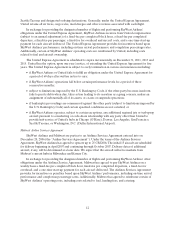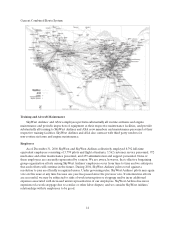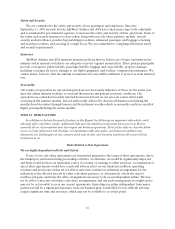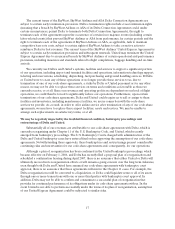SkyWest Airlines 2006 Annual Report Download - page 13
Download and view the complete annual report
Please find page 13 of the 2006 SkyWest Airlines annual report below. You can navigate through the pages in the report by either clicking on the pages listed below, or by using the keyword search tool below to find specific information within the annual report.7
(“ExpressJet”), Horizon Air Industries, Inc. (“Horizon”) (owned by Alaska Air Group,Inc.), Mesa Air
Group, Inc. (“Mesa”), MAIR Holdings, Inc. (“MAIR”), PinnacleAirlines Corp. (“Pinnacle”), Republic
Airways Holdings Inc. (“Republic”) and Trans State Airlines, Inc. Majorairlines award contract flying to
these regional airlinesbased upon,but not limited to, the following criteria: lowcost,financialresources,
overall customer service levels relating to on-time arrivaland departure statistics, cancellation of flights,
baggagehandling performance and theoverall imageof theregional airline as a whole. The principal
competitive factors on pro-rate flying includefare pricing, customer service, routes served, flight schedules,
aircraft typesand relationships with major partners.
The principal competitivefactors for code-share partner regionalairlines arecode-share agreement
terms, customer service, aircraft types, fare pricing, flight schedules andmarkets and routes served. Based
on the size of the combinedoperations of SkyWest Airlines and ASA, we are the largest regional airline in
the United States. However, some of the major and low-cost carriers are larger, and may have greater
financial and other resources thanSkyWest Airlines andASA. Additionally, regional carriersownedby
major airlines,such as AmericanEagle andComair, mayhave accessto greaterresources at theparent
level than SkyWestAirlines and ASA, and may have enhanced competitive advantages since they are
subsidiaries of major airlines. Moreover,federalderegulation of the industryallowscompetitorsto rapidly
enter our markets and to quickly discount and restructure fares. The airlineindustry is particularly
susceptible to price discounting becauseairlines incur only nominal costs to provide service to passengers
occupying otherwise unsold seats.
Generally,the airline industry is highly sensitive to general economic conditions, in large part dueto
the discretionary nature of asubstantialpercentage of both business andleisure travel. Many airlineshave
historically reported lower earnings or substantial losses during periods of economic recession, heavy fare
discounting, high fuel costs andotherdisadvantageous environments. Economic downturns combined with
competitive pressures have contributed to a numberofreorganizations, bankruptcies, liquidations and
business combinations among major and regional carriers. The effect of economic downturns is somewhat
mitigated by the predominantly contract-basedflying arrangements of SkyWest Airlinesand ASA.
Nevertheless, the per passengercomponent in such fee structure would be affected by an economic
downturn. In addition, if Delta or United, or oneor more other code-share partners we maysecure in the
future, experience aprolonged decline in passengerload or areharmed by lowticketprices or highfuel
prices, they will likely seek to renegotiate their code-share agreements with SkyWest Airlines and ASA or
cancel flights in order to reduce their costs.
Industry Overview
Majors, Low Cost Carriers and Regional Airlines
Theairline industry in the United States has traditionally beendominated by severalmajor airlines,
including American, Continental Airlines, Inc. (“Continental”), Northwest, US Airways, Delta and United.
Themajor airlines offer scheduled flights to most major U.S. cities, numerous smaller U.S. cities, and cities
throughout the world through a huband spoke network.
Low cost carriers, such as Southwest Airlines Co. (“Southwest”), JetBlue Airways Corporation
(“JetBlue”), US Airways, Frontier Airlines, Inc. (“Frontier”) and AirTran Airways, Inc. (“AirTran”),
generally offer fewer conveniences to travelers andhave lower cost structures than major airlines,which
permits them to offer flights to and from many of the same marketsas the major airlines, but at lower
prices. Low cost carriers typically fly directflights with limited service to smaller cities,concentrating on
higher demand flights to andfrom major population bases.
Regional airlines, such as ASA, ExpressJet, Mesa, MAIR, Pinnacle, Republic and SkyWest Airlines,
typically operate smalleraircraft on lower-volumeroutes than majorandlow cost carriers. Several regional
airlines, including American Eagle, Comairand Horizon, are wholly-owned subsidiaries of major airlines.


